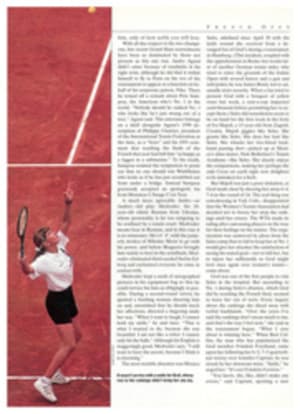
Wimbledon's First Wunderkind
Lottie! Lottie!" the crowd chanted as the tall, dark-haired girl at Centre Court started to blush. In her long white dress, black wool stockings and sturdy shoes, the teenager stood waiting to accept her trophy as the Wimbledon women's champion of 1887. Charlotte (Lottie) Dod had just reeled off 10 straight games to close out her final-round match 6-2, 6-0 against the reigning champion, 23-year-old Blanche Hillyard. Dod was so overpowering that the second set lasted a mere 10 minutes, during which Hillyard won only 10 points.
"The Little Wonder," as the press called her, in the flannel cricket cap, had established a record that would still stand more than 100 years later: the youngest woman to win the Wimbledon singles title. She was only 15 years old. While many stars of tender years would follow Dod to Centre Court, blaze briefly, then burn out with humbling speed, this wunderkind would go on to become one of the most accomplished sportswomen ever. Because she competed successfully at the highest levels in half a dozen sports, Dod is arguably the greatest all-around female athlete in history, with dutiful nods to Babe Didrikson Zaharias and Jackie Joyner-Kersee, of course.
Dod was born on Sept. 24, 1871, at Edgeworth in Cheshire, England, and her birth occurred at an auspicious time. Only a few months later and about 100 miles away, the first organized tennis match took place, at Leamington. Soon Dod's well-to-do parents decided to redesign their large garden to accommodate two tennis courts: one hard (made of crushed stone), one grass. The groundwork for Dod's future was literally laid in her own backyard.
The youngest of four children, Lottie was the last to pick up a racket, doing so at the age of nine in order to make a "four-handed" game with her older sister and two older brothers. This was four years before a women's event was played at Wimbledon. Three years later, in 1883, she paired with her sister, Ann, who was eight years her senior, and began entering doubles tournaments—and winning prizes. Her singles debut, in 1885 at Waterloo, in Cheshire, was nothing short of spectacular. The slender 13-year-old swept the tournament by winning not only the women's singles but the doubles and mixed doubles as well.
The following spring Dod began the season at Bath, the first of several tournaments on an unofficial women's circuit, with a sensational 7-5, 6-4 final match victory over Maud Watson, winner of the first women's title at Wimbledon, in 1884. The 23-year-old Watson, who had a string of 55 victories over five years going into the Bath event, had never lost in singles competition. One observer who saw Dod play described her as "so strong and sturdy and looking so jolly."
A sweet, round-faced schoolgirl she might have been, but beneath that carefree exterior was a fierce competitor. With her drive and physical gifts (at 5'6" she was tall for that era), Dod was the first real female athlete in tennis, eschewing the traditional "feminine" style of play. "As a rule, ladies are too lazy at tennis," she once said. "They should learn to run and run their hardest, too, not merely stride. They would find, if they tried, that many a ball, seemingly out of reach, could be returned with ease; but instead of running hard they go a few steps and exclaim, 'Oh, I can't,' and stop."
As a girl, however, Dod did have one advantage over her older opponents. Because of her age, convention allowed her to wear a shorter skirt than those worn by mature women players and to dress without the steel-ribbed corsets that were then in fashion. With her physical style of play she exploited this advantage as long as she could. However, even in the ankle-length skirt that she was eventually required to wear, Dod was still clearly superior to her rivals. Her great shot was the forehand drive, hit, as many who saw her contended, with the pace of a man's. The first woman to volley and smash, Dod, according to one observer, was able to "use her shoulders with a freedom we have not noticed in any other lady." Harry Scrivener, who wrote for London's Morning Post, claimed that "in the matter of her play she is absolutely without weakness."
By 1888, Dod's game was considered so daunting that officials at Bath that year asked her to cede the first point in each game to her competitors. Only Hillyard refused the advantage, preferring to meet her old rival on even terms. Extended to three sets only once—by Hillyard—Dod won the tournament for the third year in a row. Hillyard's luck didn't improve later that season when she met Dod in their second Wimbledon showdown. In a match that lasted 35 minutes, Hillyard was overwhelmed by the teenager 6-3, 6-3.
Dod decided not to defend her Wimbledon title in 1889 and instead went sailing for several months in the North Sea with Ann. Upon her return to Cheshire, Lottie played only a handful of matches, none of them singles. By the end of the season Ann had married, and Lottie, perhaps in reaction, decided to quit the game. When her sister retired from competitive play, Lottie must have felt a keen sense of loss. Tennis had been the Dod family's game. When competing in tournaments, Lottie had always entered several events—doubles with her sister and often mixed doubles with her brothers. With Ann unavailable, Lottie's enjoyment of the game faded.
Nevertheless, Dod's competitive fires took her back to tennis after a two-year hiatus. Returning to Wimbledon in 1891 and seemingly playing better than ever, she won the women's singles title—and repeated in 1892 and '93.
In 1893, at the age of 21, she left tennis for a second, and final, time. Her retirement, however, was hardly to the sidelines. "The great joy of games is the hard work entailed in learning them," she once said. So, after scaling Wimbledon, the Mount Everest of tennis, Dod believed that some new challenge was in order. For her it was golf.
In 1894 she made her debut in the British Women's Open Championship at the Littlestone Golf Club in Kent, prompting one clever journalist to quip, "Now Lottie Dod, so neatly shod/Steps forth upon the tee./On tennis green, she is the Queen./At golf what will she be?"
It didn't take long for her countrymen to find out. At both the 1898 and '99 Opens, Dod reached the semifinal rounds, and in 1904 she won the championship, at Troon.
Not content to rest during the off-season, Dod joined Great Britain's women's field hockey team in 1899 and '90 in its games against Ireland, and after taking up archery, she brought home a silver medal from the 1908 Olympics. She also became an expert figure skater, passing international tests to qualify as a judge in that sport. Her insatiable hunger for greater and greater challenges led her to become one of the first women to toboggan down the treacherous Cresta run, while on a vacation in St. Moritz, Switzerland. Dod also took up and mastered sculling, horseback riding, mountaineering, bridge and even billiards. In her later years, as the lead contralto with London's prestigious Madrigal Society, she gave a command performance before Queen Mary; and for her services as a visiting nurse during World War I, she was awarded a Red Cross gold medal.
It is said that at the time of her death, on June 27, 1960, 88-year-old Charlotte Dod was listening to the 83rd Wimbledon Championships on her radio in a nursing home in Sway, near England's southern coast. Only 70 miles away the hydrangeas were in bloom outside the All England Club, and the grass courts inside were worn from nearly a week of constant play. In just a few days the women's final would be played. At the end of the match the crowd would stand and cheer just as they had 73 years earlier for Dod, though the chant echoing through the grandstands would be different this time, and a different young, dark-haired sensation, Maria Bueno of Brazil, would be the Queen of Wimbledon.
ILLUSTRATION
ANASTASIA VASILAKIS
Dod and lawn tennis were born about the same time, and both flourished in the 1880s and '90s.
ILLUSTRATION
ANASTASIA VASILAKIS
Arguably the greatest female athlete ever, Dod mastered every sport at which she tried her hand.

